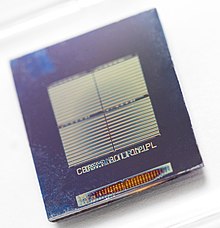 Memristor developed by the University of Illinois at Urbana-Champaign and National Energy Technology Laboratory | |
| Invented | Leon Chua (1971) |
|---|---|
| Electronic symbol | |
A memristor (/ˈmɛmrɪstər/; a portmanteau of memory resistor) is a non-linear two-terminal electrical component relating electric charge and magnetic flux linkage. It was described and named in 1971 by Leon Chua, completing a theoretical quartet of fundamental electrical components which also comprises the resistor, capacitor and inductor.[1]
Chua and Kang later generalized the concept to memristive systems.[2] Such a system comprises a circuit, of multiple conventional components, which mimics key properties of the ideal memristor component and is also commonly referred to as a memristor. Several such memristor system technologies have been developed, notably ReRAM.
The identification of memristive properties in electronic devices has attracted controversy. Experimentally, the ideal memristor has yet to be demonstrated.[3][4]
- ^ Chua, L. (1971). "Memristor-The missing circuit element". IEEE Transactions on Circuit Theory. 18 (5): 507–519. CiteSeerX 10.1.1.189.3614. doi:10.1109/TCT.1971.1083337.
- ^ Chua, L. O.; Kang, S. M. (1976-01-01), "Memristive devices and systems", Proceedings of the IEEE, 64 (2): 209–223, doi:10.1109/PROC.1976.10092, S2CID 6008332
- ^ Cite error: The named reference
Pershin_2018was invoked but never defined (see the help page). - ^ Cite error: The named reference
Kim_2019was invoked but never defined (see the help page).